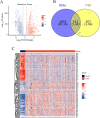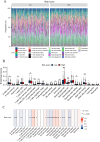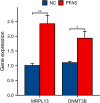Integrated network toxicology and bioinformatics reveal PFAS-driven prognostic biomarkers and molecular mechanisms in breast cancer: insights from transcriptome analysis and molecular docking
- PMID: 40705188
- PMCID: PMC12290136
- DOI: 10.1007/s12672-025-03084-z
Integrated network toxicology and bioinformatics reveal PFAS-driven prognostic biomarkers and molecular mechanisms in breast cancer: insights from transcriptome analysis and molecular docking
Abstract
Background: Per- and polyfluoroalkyl substances (PFAS), pervasive environmental contaminants, are increasingly linked to breast cancer, yet their molecular mechanisms remain unclear. This study integrates network toxicology and bioinformatics to elucidate PFAS-associated pathways and prognostic biomarkers in breast cancer.
Methods: Using the TCGA-BRCA dataset, we identified differentially expressed genes (DEGs) between normal and breast cancer tissues. We cross-referenced these genes with PFAS-related genes from the Comparative Toxicogenomics Database (CTD) to identify common targets. Enrichment analysis, network construction, and survival analysis were performed to elucidate the biological mechanisms and prognostic value. The CIBERSORT algorithm assessed immune cell infiltration, and molecular docking evaluated interactions between PFAS compounds and key genes.
Results: We identified 141 common DEGs, significantly enriched in pathways related to cytokine activity, growth factor activity, and chemokine receptor binding. A PFAS-toxicity target-breast cancer network illustrated potential mechanistic pathways. Six key prognostic genes (MRPL13, LEF1, ATP7B, IFNG, SFRP1, DNMT3B) were identified, forming a risk model that stratified patients with significant differences in survival. Higher risk scores were associated with advanced stages, specific histological types, and hormone receptor statuses. Immune cell infiltration analysis revealed distinct profiles between high and low-risk groups, with high-risk patients exhibiting elevated activated T cells and macrophages. Molecular docking showed strong interactions between PFAS compounds (PFOS and PFDE) and DNMT3B, suggesting potential gene function disruptions.
Conclusion: PFAS exposure is linked to altered gene expression, immune cell infiltration, and potential disruptions in key genes, contributing to breast cancer development and progression. These findings provide insights into potential therapeutic targets and underline the importance of addressing environmental factors in breast cancer management.
Keywords: Bioinformatics; Breast cancer; Molecular docking; Network toxicology; Per- and polyfluoroalkyl substances; Tumor microenvironment.
© 2025. The Author(s).
Conflict of interest statement
Declarations. Ethics approval and consent to participate: This study utilized genomic data from The Cancer Genome Atlas (TCGA), a publicly available dataset. As such, individual patient consent and ethics approval were not applicable to this study. However, we acknowledge that TCGA data has been ethically collected, and appropriate informed consent for the use of the data was obtained from patients as part of the original TCGA research protocols. Consent for publication: Not applicable. Competing interests: The authors declare no competing interests.
Figures








Similar articles
-
Elucidating the impact of PFAS exposure on diabetes through integrated network toxicology.Toxicol Mech Methods. 2025 Aug 13:1-13. doi: 10.1080/15376516.2025.2544030. Online ahead of print. Toxicol Mech Methods. 2025. PMID: 40804795
-
Network toxicology and immune-metabolic dysregulation: linking per- and polyfluoroalkyl substances exposure to osteoarthritis pathogenesis.Toxicol Res (Camb). 2025 Jun 19;14(3):tfaf077. doi: 10.1093/toxres/tfaf077. eCollection 2025 Jun. Toxicol Res (Camb). 2025. PMID: 40585420
-
Integrated proteomics and transcriptomics analysis reveals key regulatory genes between ER-positive/PR-positive and ER-positive/PR-negative breast cancer.BMC Cancer. 2025 Jul 1;25(1):1048. doi: 10.1186/s12885-025-14451-y. BMC Cancer. 2025. PMID: 40597935 Free PMC article.
-
Association between per- and polyfluoroalkyl substances exposure and risk of diabetes: a systematic review and meta-analysis.J Expo Sci Environ Epidemiol. 2023 Jan;33(1):40-55. doi: 10.1038/s41370-022-00464-3. Epub 2022 Aug 15. J Expo Sci Environ Epidemiol. 2023. PMID: 35970987
-
Cost-effectiveness of using prognostic information to select women with breast cancer for adjuvant systemic therapy.Health Technol Assess. 2006 Sep;10(34):iii-iv, ix-xi, 1-204. doi: 10.3310/hta10340. Health Technol Assess. 2006. PMID: 16959170
References
-
- Kim S, Thapar I, Brooks BW. Epigenetic changes by per- and polyfluoroalkyl substances (PFAS). Environ Pollut (Barking Essex: 1987). 2021;279:116929. - PubMed
-
- Petersen KU, Larsen JR, Deen L, Flachs EM, Hærvig KK, Hull SD, Bonde JPE, Tøttenborg SS. Per- and polyfluoroalkyl substances and male reproductive health: a systematic review of the epidemiological evidence. J Toxicol Environ Health Part B Crit Reviews. 2020;23(6):276–91. - PubMed
-
- Wan MLY, Co VA, El-Nezami H. Endocrine disrupting chemicals and breast cancer: a systematic review of epidemiological studies. Crit Rev Food Sci Nutr. 2022;62(24):6549–76. - PubMed
LinkOut - more resources
Full Text Sources
